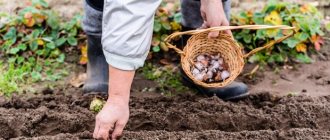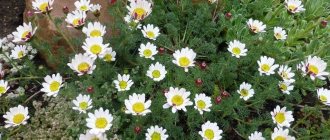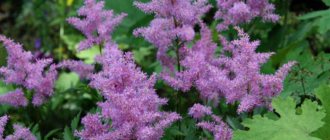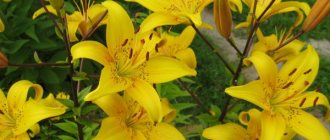original design of the flower bed
To ensure that the tree is less damaged by various pests, it is necessary that the space under it is always clean. The tree trunk circle will not stand out sharply against the background of the surrounding greenery if you arrange a flower bed under the tree.
It is advisable to take into account some of the features of this arrangement of the flowerbed. Select flowers for her that tolerate the lack of sunlight well, for example, and water them abundantly.
As you can see in the photo, the flowerbed is decorated simply amazingly. This effect is achieved by the asymmetrical shape of the flowerbed and its, again, asymmetrical framing. The plants are planted very competently, so that the root collars of the trees are not covered with soil.
Brick flower bed under a tree
In general, arranging a flower bed under a tree is a good idea in terms of saving space. After all, not every plot can have a gorgeous flower bed. And there is always free space around the tree. Here we see how you can make a small, neat flowerbed out of brick. Although the material can be any, paving stones are also perfect.
High flower bed under a tree
Here, as you can see, you can make a flowerbed in several tiers. In general, it is very convenient to make high flower beds under a tree - there is support. White brick is used here, but other materials are also suitable - stone, paving stones, small blocks. In general, creating a multi-tiered flower bed with a beautiful garden border is certainly an interesting solution. Just do not forget that for many trees, filling the root collar with soil can provoke rotting of the trunk, so it is advisable not to fill it to a height of more than 10 - 12 centimeters.
Even a low fence of twigs
You can make a flowerbed under a tree without any fencing at all, as in this picture, it also turns out very beautiful. Beautiful flowers look very good in contrast with the green lawn.
Autumn
- Morrow sedge - 20-60 cm, leaves are light green, herbaceous.
- Japanese anemone - rhizomatous anemone, 60-140 cm, white or pink flowers.
- Gentian latinosa - 20-60 cm, stem with oppositely located pointed deep green leaves, at the end of which from one to three blue bell-shaped flowers are formed.
Japanese anemone, Morrow's sedge, gentian
Original flower bed under a tree
But these photographs show a rather original solution for flower beds. On the left in the photo, the very location near the stairs is interesting. A high flower bed under a tree on the rise seems to decorate the entrance. In the second photo, both the tree itself and the flowerbed under it are original.
So flower beds under a tree are beneficial both in aesthetic terms and in saving space on a summer cottage.
DIY flowerbed under a tree
How to design the tree trunk space
What is the difference between a flower bed in an open space and a flower bed under a tree ? Mainly by the choice of plants and soil treatment. There is such a concept - the climate of the tree trunk zone. It is this climate that determines what can grow under a tree and what cannot. For example, if spruce trees are planted on your site, then due to the dense shade and acidic soil, practically nothing can grow under them. But the apple tree is perfect for setting up a flower bed under it; it provides diffused shade that will protect from direct rays and at the same time leaves enough light for favorable growth.
Also not the last
issue of soil cultivation .
Here the approaches differ. Particularly advanced gardeners prefer mulching using sawdust, straw, peat, compost, etc. It all depends on the tree. Under coniferous trees, it is best to mulch with tree bark, this is both useful and beautiful, the tree will grow faster and develop better. And yet there are different opinions on this issue. Some gardeners argue that if you plant a flowerbed under fruit trees , you must dig up the soil, just like with a regular flowerbed.
Others insist that this is not advisable; a simple fence is enough, and flowers can be planted in uncultivated soil.
In principle, both are right, just let’s compare why one and the other method is good or bad.
If you dig up an area under a tree, the advantage is that:
- the larvae of many insects, including pests, will die;
- the roots of the tree will receive more oxygen;
- You can qualitatively fertilize the soil, in which you can plant more varieties of ornamental plants and even vegetables.
The downside is:
- larvae and beneficial insects and worms will die along with the pests;
- in any case, a large number of small roots that feed the tree from the upper layers of soil (25 - 35 centimeters) will be damaged;
- the quality of the soil will become worse (meaning for the tree).
- During severe frosts, the roots may be damaged.
And now, if you don’t dig up the area in the tree trunk zone, but make, so to speak, a “wild” flower bed, then this is good because:
- the worms and roots of the plantings will over time form the necessary soil structure, most favorable for the development of the tree;
- replenishment will occur due to the natural decay of autumn leaves and grasses;
- the roots tolerate frosty winters better;
- and just less work.
But there are also disadvantages:
- Along with the beneficial fauna, pests will also survive, which can be a serious problem, so in the spring you will still have to treat the soil with something;
- loss of usable space; in an uncultivated area, the choice of planting flowers is still limited.
Here are all the pros and cons, so decide for yourself.
Features of cultivation
Perhaps the only plant in the composition that requires care is phlox. In order to get lush flowering, it must be fed properly. The first time this is done is in the spring - with nitrogen fertilizers during the period of intensive growth. In the summer, you need to fertilize phlox at least twice: during budding and flowering with a complex fertilizer with a large dose of potassium and phosphorus, and after flowering with a complex fertilizer with an increased amount of phosphorus to prepare the plants for winter. After flowering, you should cut off the faded “caps” of phlox, peduncles of hostas and daylilies. In the fall, after the first frost, the leaves of the hosta are removed, and on the threshold of winter, phlox, astilbe and daylilies are pruned.
Hosta. Photo: From personal archive/ Elena Kozhina
How to make a flower bed under a tree
If there are trees on your site, a flower garden around the trunk will be a good solution to save space. Let's look at how to make a flower bed under a tree, so to speak, a classic version of a round flower garden. . The pictures below clearly depict the entire process. The photo, of course, is from a bourgeois website, but they know how to draw beautifully, even film a cartoon.
First, in the area around the tree where you are going to plant a flowerbed, you need to remove the turf. Then it can be used for other purposes; there will probably be a place on the site where grass does not grow well.
Buy at the store or make your own metal strip with spikes to mark the edge of the flowerbed with a border. In principle, you can use anything for temporary fencing, but a strip is more convenient.
Fill the prepared area with soil to a height of eight centimeters so that the top roots do not protrude from the ground.
Level the top layer of soil and place a layer of sawdust on it so that the ground is completely covered.
You can first plant flowers and then add sawdust, but practice shows that it is better to first plant sawdust and then plant plants.
We plant flowers, which ones and how to plant them depends on what you have chosen. This issue needs to be studied in advance; there are many nuances here. Not all flowers can take root under a tree, depending on what tree it is under.
Making a border. There are many options here too. At the bottom of the article, in the gallery, you can see what types of flower beds there are and what they are covered with. The easiest way is, if you find paving stones, and you already have a temporary fence installed, it won’t be difficult to simply cover it beautifully with paving stones or, say, brick.
The flowers have been planted, all that remains is to organize regular watering, at least for the first month, and then, depend on the weather.
When the flowers grow, you can show off to your neighbors.
How to choose flowers for a flower bed under a tree
Typically, flower beds are laid out in sunny areas, on elevations, so that it is clearly visible. For a flower bed under a tree, it is not possible to create such conditions for flowers , so other approaches are used here. We must assume that the place will be shaded and damp.
Of course, a lot depends on the tree; conifers are one thing; they create a special microclimate, acidify the soil and generally create many problems for other plants. But various types of orchids, heather and similar species grow well under them. But ordinary garden flowers are unlikely to survive such a neighborhood.
Deciduous trees , and most often fruit trees grow on the plots, this is different. Their crowns are not so dense and part of the light will fall on the flowerbed. In some cases, planting flowers under fruit trees is even useful.
For example, marigolds, calendula and nasturtium repel aphids and nematodes from apple trees, and lilies of the valley will protect cherries and cherries from fruit rot.
In general, the apple tree is a very good tree for a flower bed, its crown provides a lot of diffused light and the soil under the apple tree is favorable for many plants. Periwinkles, nasturtiums, pansies, bells, forget-me-nots, daffodils, daisies, and crocuses grow well under it.
But not all trees are so supportive of their neighbors, for example, you are unlikely to be able to grow a lawn under an oak tree, and only lungwort, ferns or lilies of the valley can get along with a birch tree. Some find it by planting flowers that bloom until a thick crown appears - scillas, daffodils, hyacinths, tulips.
You can also plant bosquets around the tree as a decoration .
These are hedges made of boxwood, they look very neat and beautiful, they can be given any shape, you will get such an original border.
What to plant after the apple tree
What cannot be planted after the apple tree? It is not recommended to plant a new apple tree after the old one. Also, the pear will not take root in this place. Strawberries are not planted immediately after uprooting, but after a couple of seasons they may well take root.
What can you plant after the apple tree? After the apple tree, it is good to grow vegetables, annual herbs and ornamental flowers. Cereals and legumes grow well. Immediately after uprooting, cherries and sweet cherries can take root. But it is better to plant other trees after 4 years, when the root system has completely rotted in the soil.
Now you know what to plant under the apple tree and you can rationally design the territory of your site.










